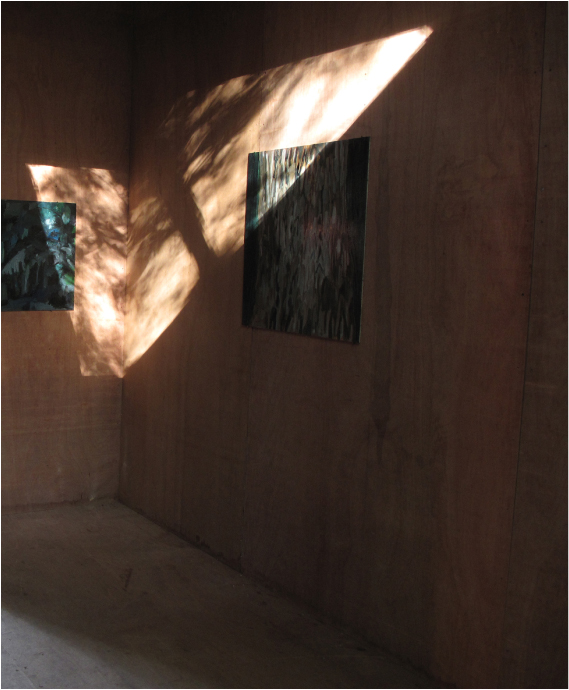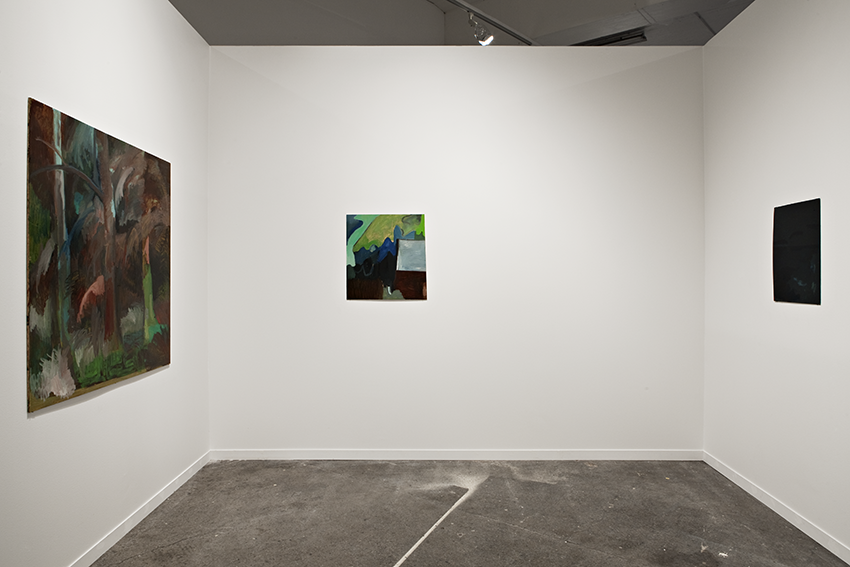Jeløya
In May 2011, after my stay at Høvikodden, Winterstudio was moved to Jeløya, an island one and a half hour drive south east of Oslo. The studio was placed in an overgrown baroque garden outside the Gallery F15 among old beech trees and on a forest floor where there was once a pond in the seventeenth century. On this imaginary island on an island, I painted from the middle of May until the opening of the 6th Momentum Biennale Imagine Being Here Now in the middle of June.
While the change of scenery was dramatic, it set the stage for a predefined view in much the same way that Kolsås had already been defined through Monet’s work. However, this type of framing functioned quite differently. Since the forest at Jeløya is planted, there is an order to the way the trees appear in relation to one another. This gives a sense of rest and coming together, in stark contrast to Høvikodden where everything was in flux due to a highway and busy boatyard. Instead of a horizontal division, here the view appeared vertically oriented. Large trees in front of my window would block off the entire view at certain angles. Instead of clear sky, the skylight was now a pool of leaves moving with the wind from the ocean and the light would change drastically inside the studio depending on weather conditions. On sunny days, the light filtered down from above projecting a shadow theater inside the studio. In this sense moving the studio from Høvikodden to Jeløya, made the experience similar to going from Iceland to the Fontainebleau forest to paint.
Out of the blue into the green
Working at Jeløya, the colors inside the studio were also different. While the light coming from the outside often had a bluish tint at Høvikodden, the arrival of spring made the trees bright green at Jeløya. The strong daytime colors outside were so intense that it gave the studio a green glow inside, at times making it difficult to paint. Like Høvikodden, the forest at Jeløya is mainly used for recreational purposes. In order to have more stable light conditions and to avoid too many visitors, I decided to start working in the early evening. The longer spring days meant it was possible to paint into the night using only natural light as a light source. However, when the sun went down, darkness came fast due to the forest enclosure, allowing only a very limited timeframe for completing new paintings. The intense colors in the daytime had an after effect in the twilight at night. I reduced the palette to shades of green and concentrated on the trees, which provided a structure and a frame to work within. Repeating the same motif under time constraints and poor light conditions made for direct translations both of the outside and my memory of it. Compared to the forest wall painted inside at Ringsveen, these scenes painted from observation started to look more formal and flatter. At Jeløya I also continued making paintings from memory of events I had observed on my way to the studio; the watering of the fields, headlights in the alleyway, an F16 bomber over the F15 Gallery, potentially on its way to Libya. Similar to Høvikodden where I made Bastard, these daily observations could also relate to world events happening outside my field of vision. Grasping the moment and juxtaposing these different impressions was a way to make this outside reality present.
New boards
At Høvikodden leftover construction materials was used as supports for new paintings. I liked the fact that the paintings had the same materiality as the studio and that they were also coming out of this building process. Since there was not much leftover material to work from at Jeløya, I decided to buy similar boards and go up in size. The larger formats and the reduced time frame for making the paintings required a different way of working. At Ringsveen and later when painting Kolsås with the students, I had added linseed oil to prevent oil from freezing. This had made the mark making more fluid. Here I prepared the whole board with linseed oil first. This allowed me to paint large surfaces without much resistance from the boards, diluting the paint, giving the paintings a fluid allover watercolor look. This wet on wet surface technique demanded a more careful handling of the paintings. I laid the boards flat to avoid the paint running and mostly used solid dark colors straight from the tube, often letting the wood itself be the primary color for the lighter parts of the painting. Because of limited space in the studio I could only work on one painting per night. I would work until it got so dark in the studio that I could not see the painting anymore; leaving the painting to dry overnight only to discover what I had done in the morning.
The room as a camera
This way of working – laying the canvas flat, the darkness of the studio and waiting for results to appear the next day - brought to mind the experience of developing photographs in high school. This made Winterstudio appear in a new light; I began to see that the studio had a likeness to old wooden camera obscura boxes. Thomas Edison´s first movie production studio – the so-called “Black Maria” also had a similar shape. Reflecting on these formal similarities, I began to wonder if the typical loft studio, with light coming from the skylight above, was a room determined by a photographic consciousness. Following this line of reasoning, it struck me that the history of painting plein-air, especially its must have had a close relation to early photography in terms of their parallel development and similar interest in keeping the subject still and having stable light conditions. This brought me back to thinking about my experiences in the Barbizon forest. Furthermore, the consistent framing that photography provided, also had a relation to how Collett went about painting the river or the way Monet captured impressions of the mountain in different weather conditions. The convention of having artist studios on top of city buildings seemed to be in line with this almost scientific organization of the workspace.
Winterstudio had provided a consistent framework where certain parameters of the paintings process could be analyzed. I became more aware of how the shift in location influenced the way I was working. The ambition to escape a photographic staging in my own work seemed futile. The visual structure of photography appeared integrated into the very architecture and my surroundings. This had not been evident when the studio was part of the architectural body of the building in Oslo. My attraction towards predefined framed views of the mountain and the forest also appeared connected with photography which Winterstudio itself reinforced. Even the paintings made from memory, which often related to arresting a movement and capturing fragments of passing events, had a relation to this. The growing restlessness I felt was probably connected with the same endless pursuit of documenting our lives that digital photography makes possible. I felt I had come full circle from my point of departure and the desire to move beyond having a direct reference to photography in painting.
Presence in the studio
My new discovery came with a twist. If the studio acted like a life-size camera obscura, the light should be coming through the backdoor and I should actually be looking into box the from the skylight. In Winterstudio I did not have this type of godlike view from above. Instead I acted in the box where I was looking through the lens out the window and not on a projection on an interior wall. Instead of looking away from my subject, I was facing it! This was very different from observing a photograph, which is always removed from the subject it depicts. As a fixed image, a photograph is not in constant flux like nature and the memory of it. My presence in the box mattered for the type of immediacy I wanted to communicate; in fact, it depended on it.
The desire to look outside reflected my need to take reality into the studio. This type of looking, not in the camera, but at the subject depicted had for me a closer relation to digital photography, where the camera display opens up for another type of relation to the outside. Through this way of working I became more aware of the fine interconnections between different media that exist in painting. This idiosyncratic way of witnessing place through observation of movement, distance, surface, and light made painting a place of its own. It corresponded to digital imagery where the image is broken down into pixels that can interchange and there is less of a unique and singular image and more of a picture that is informed by other pictures in flux. In my endeavor to keep conditions consistent, I had instead revealed how experiences of places are always interconnected and in flux. Winterstudio was no longer just a studio; it had become a furnished home for these new ideas.
Imagine Being Here Now
The 6th Momentum Biennial Imagine Being Here Now opened 18 June and ran through 2 October 2011. The curators had chosen to make small cubicles for each artist in the exhibition space at Momentum Kunsthall. I thought it would be interesting to play around with ideas of repetition and singularity, being “in” and “out” of place, and the idea of “site” and “non-site” which the title of the show and the uniformity of the exhibition space itself seemed to possess. One way of doing this was to show works both in the Winterstudio where the paintings were made and in the white cube situation in the main exhibition hall in Moss. The idea was to afford the attentive viewer a déjà vu experience going from one exhibition venue to the next. A time lapse could occur and with it a condition of unrest as the viewer would be transported to another place by the experience of the artwork – from the painting to the studio and back. With paintings of the same place in two locations, the state of presence could again enter the realm of the imagined.










